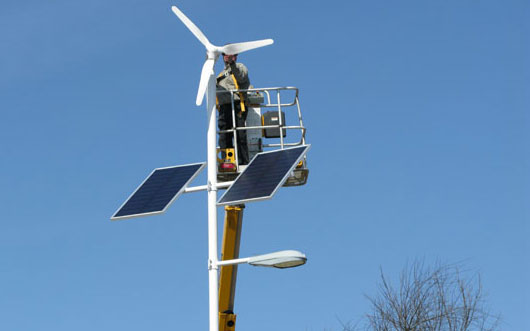While it won’t be going into orbit, EverLast’s outdoor lighting system is still accomplishing a pretty neat feat for the spacefaring agency.
The Jackson, Michigan-based company is behind the sensor-backed tech that’s providing an 0ff-grid parking lot at the NASA Johnson Space Center in Houston, Texas with zero-emissions, energy efficient outdoor induction lighting. How? With the energy generated by a wind turbine and photovoltaic panels.
It’s a combo that piqued NASA’s interest, says Alex Orr, Commercial Sales Representative for EverLast. “Other systems rely solely on solar or wind energy, rendering them more susceptible to climate fluctuations,” he states in a company release. Certainly, the battery-backed energy storage component is a critical to smoothing things out. Another bonus: no unsightly wiring-to-the-grid projects. As you can see in the picture accompanying this post (taken from an install at Lawrence, MI), it’s as self-contained as it gets.
NASA’s installation straddles a couple of recent trends in cleantech: the rise of sensor-based smart lighting technologies and an innovative growth spurt in small scale renewable energy solutions, particularly wind.
On the lighting side of the fence, the industry is expecting a surge in the smart lighting market this year as businesses strive to cut energy and maintenance costs. And as for wind power, TAK studio got the industry buzzing early last year with its innovative concept for the Greener Gadgets design competition, the Turbine Light for roadways. Small scale wind is also getting a boost from researchers at Cornell University in Ithaca and startups like Humdinger Wind Energy out of Hawaii and Michigan’s Windtronics that are looking past traditional bladed designs for capturing energy from a stiff breeze.
Expect more smart, sustainable outdoor lighting systems to crop up as property and facilities managers come to realize that “off-grid” no longer has to mean “in the dark.”
Correction: This post erroneously classified it as an LED-based lighting system in an earlier version.
Image credit: EverLast


It’s a shame they didn’t go for LED lighting (as you had it flagged earlier). That way they’d have got a more efficient use of the energy generated. Outdoor LED lighting has come on leaps and bounds in the last few years and is even cheap enough for NASA by now 🙂
I know, right! LEDs would have made it one awesomely tied-together, energy-efficient package.